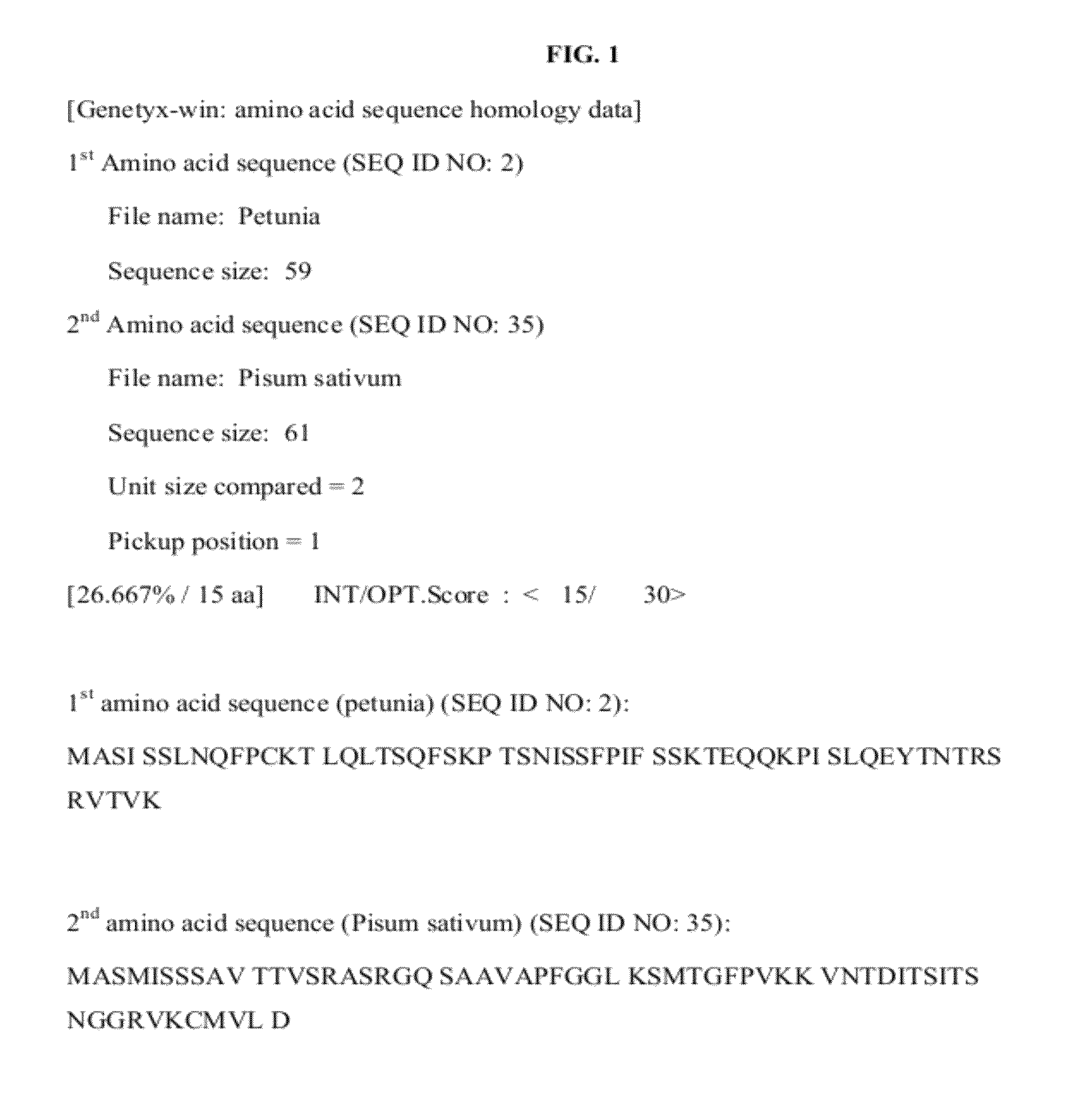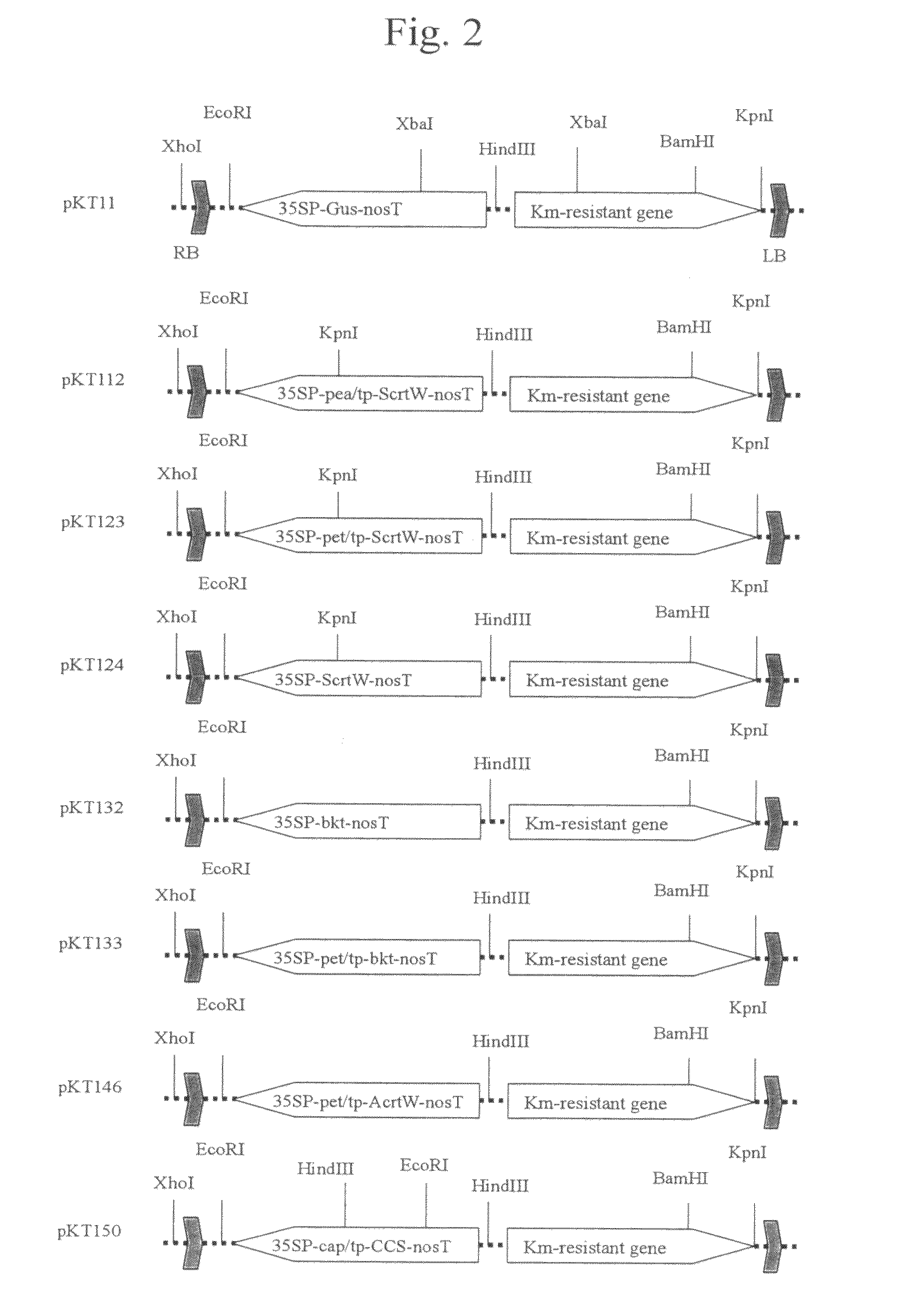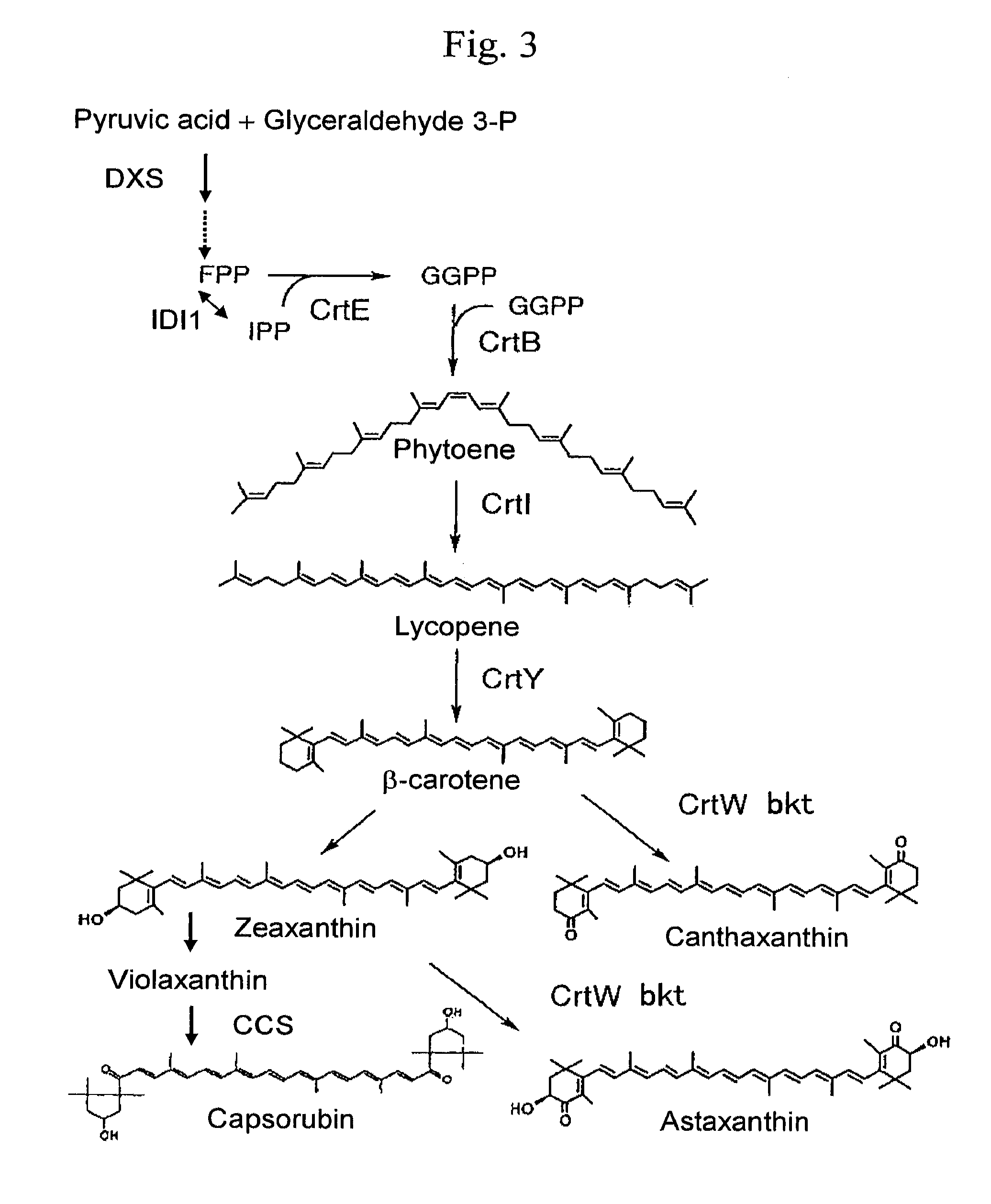Peptide transporting to chromoplasts in petals and method of constructing plant having yellowish petals by using the same
a technology of chromoplasts and peptides, which is applied in the direction of peptides, tissue culture, dna/rna fragmentation, etc., can solve the problems of inability to determine genes that should be enhanced for increasing the amount of carotenoid produced without trial, and the time-consuming and labor-intensive cross-over, etc., to achieve the effect of enhancing a yellowish flower color and imparting yellowish flower color
- Summary
- Abstract
- Description
- Claims
- Application Information
AI Technical Summary
Benefits of technology
Problems solved by technology
Method used
Image
Examples
example 1
Obtaining cDNA of Petunia Fibrillin
[0085]An in vitro petunia seedling (Petunia hybrida: light yellowish petunia (a breeding line of Kirin Beer Kabushiki Kaisha)) was acclimatized to culture soil (composition: Akadama (small): leaf mold: vermiculite=6:3:1) and cultivated according to a conventional method, leading to flowering. Preparation of mRNA from a petal was carried out using RNeasy kits (Qiagen). Synthesis of total cDNA was carried out using a SuperScript First-Strand Synthesis System (Invitrogen).
[0086]The resulting cDNA was subjected to PCR (conditions: 95° C. for 5 minutes; 95° C. for 30 seconds, 55° C. for 30 seconds, and 72° C. for 1 minute for 30 cycles; and 72° C. for 10 minutes) with the use of primers [Fib5-1: CAGCTGGAATCCAAGAACCCTA (SEQ ID NO: 15) and Fib3-1: GTAAGTGGTCAGCAGCCATGAT (SEQ ID NO: 16)] that had been produced based on reference information regarding the capsicum fibrin gene [Deruere et al., Plant Cell, 6, 119-133 (1994)] and the cucumber fibrin gene [Vish...
example 2
Obtaining Transit Peptide cDNA of Petunia Fibrillin
[0087]It was noticed that an amino acid sequence of a transit peptide predicted from the cDNA sequence of petunia fibrillin has no homology to an amino acid sequence of a transit peptide of Pisum sativum, such transit peptide being the most widely used as a transit peptide of a chloroplast [Schreier et al., EMBO J., 4, 25-32 (1985)]. Such fact was considered to be related to information regarding efficient transport of proteins to chromoplasts (FIG. 1).
[0088]Thus, PCR (conditions: 95° C. for 5 minutes; 95° C. for 30 seconds, 55° C. for 30 seconds, and 72° C. for 1 minute for 30 cycles; and 72° C. for 10 minutes) was carried out using DNA of the clone PetCarP4 as a template and primers [U383: ACTAGTACGGCTTTTACTGTGACTCTTG (SEQ ID NO: 17) and U384: TCTAGATTCTTCACTCATTTCCTCTC (SEQ ID NO: 18)]. The PCR product was subjected to TA cloning with the use of a pCR4-TOPO vector (Invitrogen) such that plasmid pTP1 was obtained, followed by nucl...
example 3
Production of Vectors for Plant Transformation with the Use of Ketolase Genes
[0089]As the ketolase genes, the ScrtW gene (SEQ ID NO: 5) obtained by modifying crtW (a ketolase gene of Agrobacterium) for a torula yeast, the ketolase gene of Alcaligenes sp. PC-1 (AcrtW gene: SEQ ID NO: 6), and the ketolase gene of Haematococcus pluvialis (bkt gene: SEQ ID NO: 7), each of which were reported by Miura et al. [Appl. Environ. Microbiol., 64, 1226-9 (1998)], were used.
[0090]A plasmid p35SP-pt / tp-ScrtW comprising an expression cassette construct in which a 35S promoter (35SP), cDNA of fibrillin transit peptide, ScrtW, and a nos terminator (nosT) were aligned in such order was obtained by ligating cDNA of a transit peptide (pt / tp) of petunia fibrillin, which had been cleaved from pTP1 with XbaI and SpeI, to an XbaI site located between a 35S promoter and ScrtW of a plasmid p35SP-ScrtW containing a construct comprising a cauliflower mosaic virus 35S promoter (35SP), ScrtW, and a nos terminator...
PUM
| Property | Measurement | Unit |
|---|---|---|
| temperature | aaaaa | aaaaa |
| temperature | aaaaa | aaaaa |
| diameter | aaaaa | aaaaa |
Abstract
Description
Claims
Application Information
 Login to View More
Login to View More - Generate Ideas
- Intellectual Property
- Life Sciences
- Materials
- Tech Scout
- Unparalleled Data Quality
- Higher Quality Content
- 60% Fewer Hallucinations
Browse by: Latest US Patents, China's latest patents, Technical Efficacy Thesaurus, Application Domain, Technology Topic, Popular Technical Reports.
© 2025 PatSnap. All rights reserved.Legal|Privacy policy|Modern Slavery Act Transparency Statement|Sitemap|About US| Contact US: help@patsnap.com



